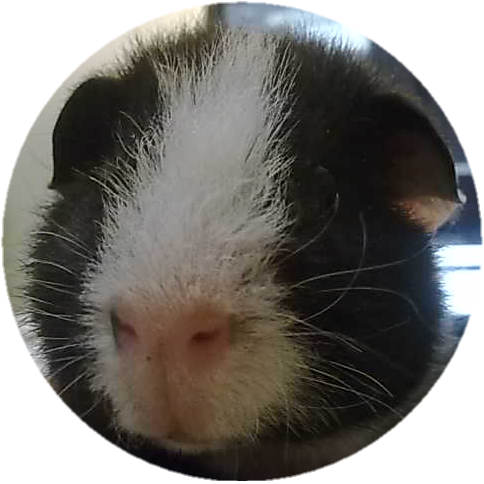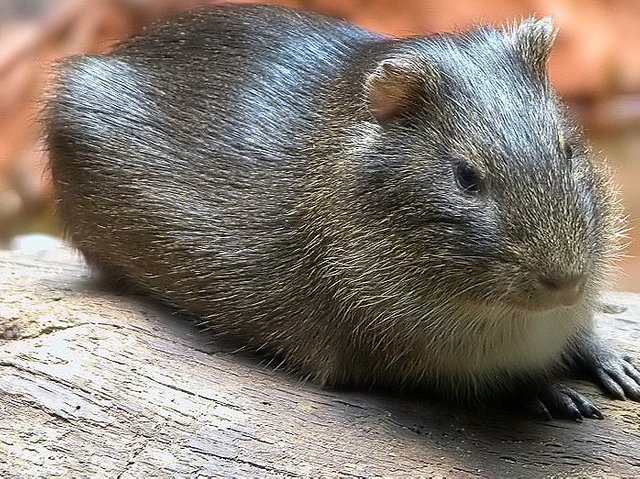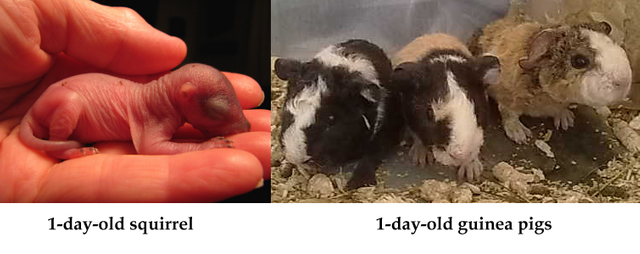Guinea Pigs: A rodent that belongs to us

The Guinea Pig - scientific name Cavia porcellus - is a rodent that truly belongs to us.
Cavia porcellus does not have a wild animal equivalent. It exists as a species only because of us. The creation of Cavia porcellus was a several thousand year process during which guinea pigs lived and reproduced within rooms and pens constructed by the native people of South America. This domestication process started at least 5000 - 9000 years ago and the intended purpose was to keep them as meat livestock, not pets. The original animal that the native people started out with is apparently extinct today, but genetic studies have found that Cavia tschudii (the "Montane guinea pig") is a wild ancestor that is still living today.

Cavia aperea, one of the wild guinea pig species
Photo credit: Petra Karstedt (= PetraK; www.Tiermotive.de)
Attribution-Share Alike 2.0 Germany license.
The original animal (as well as Cavia tschudii) had physical and behavioral adaptations that are apparent in our guinea pigs today:
- They are adapted for survival as a prey species that lives in grassy areas. Speeding through and under grass is their escape tactic.
- The number of toes on guinea pigs' feet is decreased. Guinea pigs have only 3 toes on their back feet and 4 on the front. Fewer toes is characteristic of prey animals that faced evolutionary pressure to escape predators through running. Hooved mammals went through a process of losing toes over time, and today for example, a horse's hoof is formed from one large toe.
- Cavia tschudii and similar wild guinea pigs are heavily preyed upon in their natural habitat. So, guinea pigs have a high reproductive rate, generally producing 5 litters per year without breaks between pregnancies.
- Like other grassland prey animals such as antelopes and horses, guinea pigs are born at an advanced stage of development. They are capable of running at high speed and jumping soon after birth.
- Biting is not a primary defense against predators, so guinea pigs are less inclined to bite than some other animals.

Guinea pig rear foot (3 toes)
History does not relate stories of guinea pigs sneaking onto boats, riding with sailors as unwanted vermin, and infesting much of the world (see the Norway rat for that). There are no stories of guinea pigs sneaking into houses from the European outdoors to infest grain stores, like with mice. New York City does not harbor an infestation of vermin guinea pigs. This is because guinea pigs are not hardy animals. They lived indoors for their entire domestication, in a region of the world with little temperature variability, plus were significantly inbred during their domestication. The result is that guinea pigs are not like the tough, robust rodents that infest the cities of the world or the livestock that has lived outdoors in Europe and Asia for thousands of years. Guinea pigs' health is delicate in comparison with other domesticated animals.
Guinea pigs are still raised as meat-producing livestock in South America as well as some of the islands in that region with a similar climate (there has also been some introduction of guinea pigs as meat-producing livestock into Africa). Guinea pigs raised for meat are of a relatively new breed called "Improved guinea pig" or "cuy". Cuy are the broiler chickens of the guinea pig world - they grow quickly, grow very large, and are intended for slaughter at a relatively young age. Cuy can weigh as much as 6 pounds (2.7 kilograms), which is almost twice what the pet and laboratory breeds weigh. Cuy are known for having skittish personalities which, when combined with their increased size and athletic abilities, make them a poor match for use as pets or laboratory animals.

Cuy guinea pigs in traditional South American housing
Photo credit: Julia Manzerova from the Bronx, USA, image cropped and resized, Attribution-Share Alike 2.0 Generic license.
Guinea pigs are not raised as meat-producing livestock in USA/Europe/and similar locations. Guinea pigs' delicate health combined with their dietary and climate requirements make them a terrible match for the role of a meat-producing livestock animal in those areas. In those locales, every other typical livestock animal is more sensible for this purpose.
Instead, guinea pigs in those regions are utilized as pets and as laboratory specimens. A number of pet breeds have developed over time, having different coat types and colors and in some cases, breed-specific body types. Laboratory strains include some deliberately inbred lines where the individual animals are nearly identical genetically (this is useful for some studies).
Guinea pig biology has some quirks:
- They require dietary vitamin C. This is unusual for rodents.
- They have a very long pregnancy for rodents (usually 67 days), and pups are born at a relatively advanced stage of development. If we make a strictly arithmatic comparison with human gestation times, considering the upper age limit for female guinea pig reproduction to be 4 years and the upper limit for humans to be 50, a guinea pig pregnancy is the equivalent of a human pregnancy with 2 to 4 babies that lasts for at least 2 years.
- Females become sexually fertile at around 3 weeks of age, which at first impression may seem too young. It makes more sense when we consider that guinea pigs have a gestation period that is 3 times as long as many other rodents (about 67 days) and therefore the pups are born that much more developed. Rats in comparison have a gestation period of 21 days and are sexually mature between 5 to 6 weeks of age. If we view the pups' ages from the date of conception instead of the date of birth, a 3-week-old guinea pig is 88 days old and a 6-week-old rat is 63 days old. Since guinea pigs are larger than rats when fully grown, this is in line with what would be expected for age at fertility.
- Their digestive tract is prone to disruption by oral antibiotics that do not cause problems for other animals. A disrupted digestive tract can be deadly for guinea pigs.
- They do not have tolerance for high or low temperatures. Ideal temperatures are between 65F - 75F (18.3C - 23.8C). Temperatures above 80F / 26.6C have been known to kill them. If a pregnant female gets too hot, especially if it happens repeatedly, the pups can be born with congenital problems such as limb deformities, microcephaly, mental retardation, blindness/cataracts, and paralysis.
- If a female is bred for the first time at an age of 8 months or later, she may not be able to deliver the pups normally. The pelvic bones might not separate at delivery, thereby trapping the pups inside. A c-section surgery is
required to save the mother's life in this event.
- Guinea pigs are generally more prone to having problems with delivery than other rodents. The problems stem from the pups being naturally large at birth.

Photo credit: (Left) audreyjm529, central Pennsylvania USA, resized. (Right) Thislife4now.
License: Creative Commons Attribution 2.0 Generic
Things people do with pet guinea pigs:
- Pet them and play with them
- Agility training and agility competition
- Curl up their fur
- Teach them to sit on square pillows
- Let them drive cars
- Let them ride on scooters
- Let them fly helicopters
- Watch them eat
Domestic guinea pigs have no sense of the conservation of food and water. They readily poop into their food bowls and may dump them over. It is not unheard of for guinea pigs to pee into their food bowls, ruining the food.

This was a bowl of guinea pig food
If guinea pigs could poop and pee into their water bottles, they would.
Author: Thislife4now, December 31, 2017.
If you would like to be notified when I post new articles on Steemit, you could follow me on Twitter at https://www.twitter.com/thislife4now.
Images not otherwise attributed are owned by user Thislife4now, license: Creative Commons Attribution 2.0 Generic.
Congratulations @thislife4now! You have completed some achievement on Steemit and have been rewarded with new badge(s) :
Click on any badge to view your own Board of Honor on SteemitBoard.
For more information about SteemitBoard, click here
If you no longer want to receive notifications, reply to this comment with the word
STOP